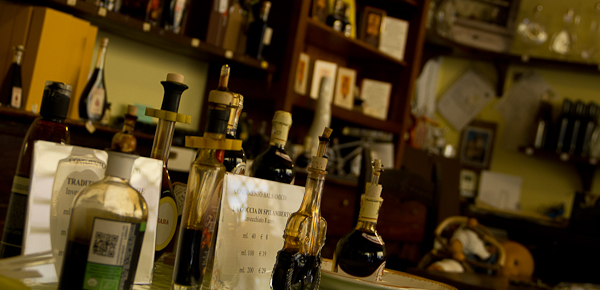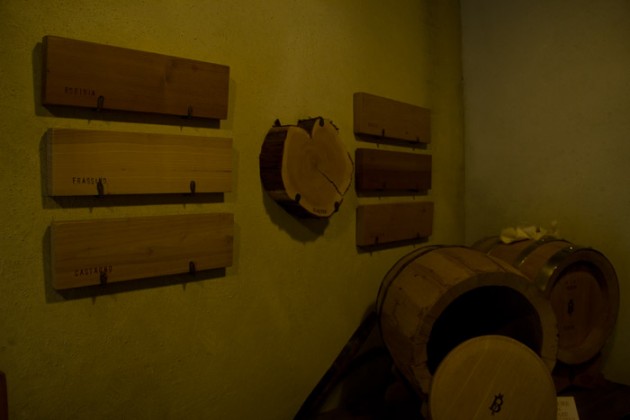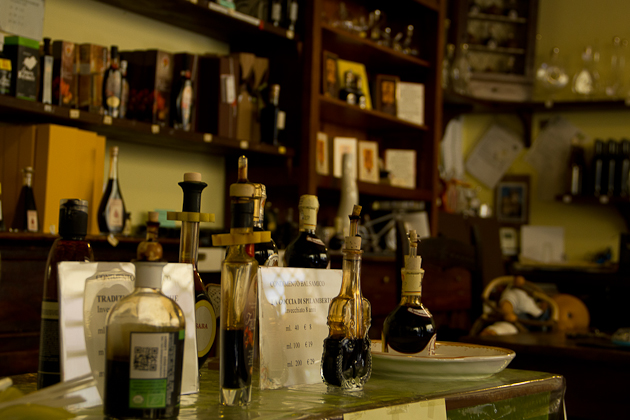What Is Balsamic Vinegar?

“What is balsamic vinegar?” Well, this staple of international food culture comes (all but the very worst of it) from the region around Modena, in Emilia-Romagna, Italy, where it is a local obsession.
Think fillet steak in a balsamic sauce (filetto di manzo all’aceto balsamico), octopus with pesto and balsamic, or – less surprisingly once you’ve tried the real deal – balsamic vinegar on ice cream.
As here:

Heading out from Modena to the little town of Spilamberto, home to the Museum of Balsamic Vinegar , countless signs marked the way to producers, still lovingly ageing it in the attics of their farmhouses.
So… What, exactly, is balsamic vinegar? (Clue: not all of it is made by farmers in their attics, otherwise the supermarket stuff would cost more than it does.)
Let’s begin with some basics. All balsamic vinegar of Modena (aceto balsamico di Modena) must be made within specific areas of the region around Modena. At least some part of the vinegar must be made from cooked grape must (the frothy mix of juice, pulp and a bit of skin that’s often the starting point for wine).
It is this cooking, plus ageing, that gives classical balsamic vinegars their sweetness, as cooking intensifies the sugars and ageing further concentrates them. It is also this that means balsamic is not a wine vinegar: because the juice is cooked before it naturally ferments and acetifies, it never becomes wine (since wine is made with raw juice).
The best balsamic vinegars are, obviously, made from 100% cooked grape must (look for “mosto d’uva” on an Italian label). The very poshest balsamic vinegars are known as aceto balsamico tradizionale di Modena DOP – Traditional Balsamic Vinegar of Modena PDO (Protected Designation of Origin).
All of these are made with 100% cooked grape must, aged for at least 12 years (for the young stuff) or 25 years (for the old stuff) in small barrels, and will run you tens of euros for a dinky little bottle.
The crappiest balsamic vinegars are sold as aceto balsamico di Modena IGP – Balsamic Vinegar of Modena PGI (Protected Geographical Indication). This is the stuff in your local supermarket, which might contain as much as 2% caramel and as little as 20% balsamic, with the bulk of it made up using industrial vinegars, but must still be made in the Modena area (law here).
Between these two, however, there are a tonne of balsamic vinegars which might not hit the precise requirements for PDO/DOP status so are legally classed as IGP/PGI. These can still be artisan, phenomenal, high-end products, made with 100% grape must (or even organic grape must), and they’ll typically market themselves as “Traditional” or Tradizionale (though the use of the word “traditional” is no guarantee of quality: look for the ingredients and the age statement).
Whisper it, but many of these vinegars are a hell of a lot more usable in salad dressings and sauce than some of the really expensive stuff. An artisan balsamic can be so sweet and so intensely flavoured that it’s better suited to a decorative cheffy swirl or drizzle, in the manner of an extremely concentrated jus, than dumping all over a rocket salad.

So: what is traditional balsamic vinegar of Modena? How is it made?
Traditional balsamic vinegar of Modena is made from traditional grape varietals only, especially Lambrusco, for its high acidity, but also Trebbiano and other regional grapes.
The grapes are crushed, the resulting juice is cooked in the open air, and then it goes into barrels, which must be made of one or more of six types of wood, to be aged in the attic acetaia, or “vinegar room”.
The ageing process itself is not dissimilar to the solera system used for sherry. Every year, half of the barrel at the end of the ageing line (be that number 12, or number 25, or anywhere in-between) is drained off for sale. That barrel is refilled from the one before it, that one is refilled from the one before that, and so on down the line, until the first (youngest) barrel is topped up with that year’s cooked grape must.
That means that every single barrel is constantly being renewed with the contents from the one before it, which not only compensates for evaporation but ensures a continual blending.
As you might imagine, there are endless refinements to this process, which is in some ways closer to wine making than anything else, from the mix of grapes chosen, to the cooking time and temperature, to the different woods and sizes chosen for the barrel: all of this enables traditional balsamic vinegar producers to control the style of their product.
Typical results are intensely sweet, gloopy, tangy and aromatic – really more of a condiment than what we’d consider vinegar.
Want to visit one? Look on the balsamic producers’ association website: they are more than happy to arrange tastings, but you need to contact them a few days in advance of your visit, you’ll need your own wheels, and you’ll likely need some Italian.

After a trip to the balsamic museum, a tasting at the shop opposite is a must — and, yes, that is a store devoted exclusively to balsamic vinegar, as well as accessories such as tasters, pipettes and jars. In a mixture of fluent Italian, simple English and absolutely terrible Italish, we tried a few drops of four separate balsamic vinegars off a little plastic spoon.
And, let me tell you, once you’ve tried the true balsamic, you will never, ever look back.
We started with an accessible, introductory number, a 5 year aged, all-organic balsamic. This had an intense depth of flavour, including the raisin notes that come to dominate the older a balsamic becomes, with plenty of acidity (a combination both of barrel size and relative youth).
Next up? A 10-y-o balsamic, produced in the traditional manner but too young to count as true Tradizionale. This was gloopy, raisiny, and very sweet, with a deliciously light acidity and a scent that reminded me of cedar – perfect for strawberries and ice cream.
Moving up the scale, we sampled a 12-y-o – more cedar aromatics, yet more sweetness, but even more balance of the sweetness and acidity. This was beyond gloopy and approaching the syrup level.
And then… Balsamic nirvana. A 25-year-aged balsamic vinegar, a syrup-textured, perfectly clear confection with notes of cedar wood, pine and raisins, intensely sweet but still with an acetic tang.
The price? 40 euros for a very small bottle (though, if you’re not in Italy, and you’d like to try the good stuff, Milan’s gastronomy central, Peck, sells balsamic vinegars online at price points up to 122 euros).
And, like the best balsamic vinegars, it barely tasted of vinegar at all. Go figure.